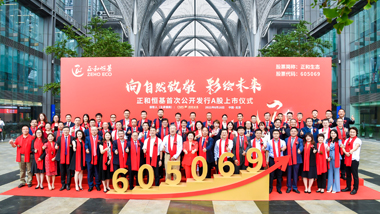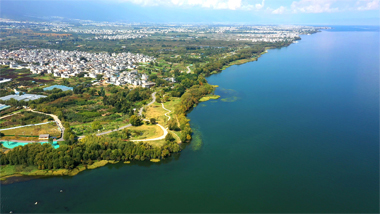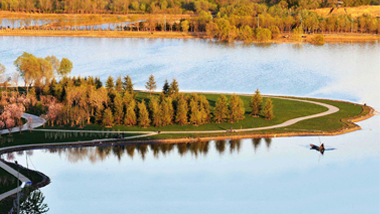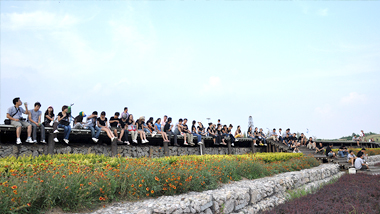Overview
The Ecological Restoration Design of Erhai Lake Riparian Buffer Zone Demonstration Section is in Erbin Village, Xiaguan Town, Dali City, Yunnan Province. It is the pilot project of the Erhai Lake waterfront restoration. The demonstration section with a total area of 16.64 hectares is defined as the technical model for ecological restoration of the entire Erhai Lake Riparian Buffer. Taking Nature-Based Solutions (NbS) as the most important guidelines, the design team used natural protection programs including ecological reconstruction, auxiliary regeneration, natural restoration, conservation, to restore the shoreline encroached upon by farmlands and hotel structures to a sustainable buffer zone for water purification and ecological restoration.
The project is in Erbin Village, Dali City, starts from HeilongDitch in the South and ends at No.7 Ditch in Chongyi Village in the north. According to the regulations of “Three Lines” ecological environment protection management of Erhai Lake, the blue line represents the boundary of Erhai Lake, which is defined by the Digital Topographic Map Surround Erhai Lake in 2007 and the Lake Boundary of 1966-Meter-Elevation surveyed in 2014. The green line outlines the preservation area of Erhai Lake, and the red line illustrates the core area of Erhai Lake water ecological protection.
Prior to redevelopment, farmlands and structures had invaded Erhai Lake. Designed based on the NbS concept, the project team took the ecosystematic values of the site into consideration such as protecting the biodiversity and controlling the non-point source pollution. They invited domestic and international stakeholders including professional experts, government, and residents to assess and diagnose the condition from the following 4 aspects and 18 indicators: ecological spatial pattern, ecosystem quality, ecological vulnerability and social participation. Non-point source pollution, habitat fragmentation and low public participation were the key problems. For site issues, the designers used natural protection programs including ecological reconstruction, auxiliary regeneration, natural restoration, conservation, and created a natural, healthy and sustainable riparian buffer zone for water purification and ecological restoration, providing a new technical model for the ecological restoration of the entire Erhai Lake Riparian Buffer.
Highlights
Objective: Water purification and ecological restoration of the lake edges
The restored riparian buffer zone is the last ecological safety buffer to the Erhai Lake. By purifying the upstream low-polluting surface water, the buffer has revitalized the natural habitats, enriched the species inhabited, and activated the sustainable circular development model of the entire Erhai Lake Basin. The buffer has became the ecological treasure of Dali’s sustainable development.
Design Approach
Renaturation:
The long-term disordered development had made the Erhai Lake riparian buffer zone invaded by farmlands and structures. A negative feedback exacerbated the ecological environment. The proportion of blue – green in typical natural lakeside wetland ecosystem and the proportion of dry land and wetland in greenspace were unbalanced. By investigating the wetland ecosystems of other highland lakes at the same latitude and the historical ecosystem characteristics of the Erhai, the blue-green ratio of 3:7 and the dry-wet ratio of 6:4 in greenspace were reconstructed, and the plant coverage and habitat fragmentation were designed in conditions which approximated the wild as closely as possible.
Lake Ecosystem Health:
The design team studied species, quantities, distribution patterns, ecological habits, seasonal characteristics and habitat preferences of plants and animals. By diversifying the water system, the natural balance and purification functions were strengthened in the site, which provided varying habitats for wildlife. The design also conserved local biotopes, removed invasive species, and introduced appropriate native species to ensure the diversity and integrity of the ecosystem, to maintain a healthy lake ecosystem.
Sustainable Future Management:
The natural succession was considered in all design and construction sequence. In the first year of construction, pioneer plant communities were introduced through terrain reconstruction, and different biological habitats built the ecosystem basis. In the next two years, the early introduction of species promoted the natural accumulation of organic matters, and slowly increased the botanical diverseness, including grasses and wildflowers, thus providing a variety of habitats for animals. After the natural succession of the community, the competition among species made the ecosystem became stable, and formed a self-management ecosystem with self-maintenance, robust anti-interference and dynamic balance.
Add low-jamming service system:
Only one cycling and walking path designed under the site condition along the lake edge acts as an ecological corridor, reducing the disturbance to the biological habitats. Low-interference infrastructures, including ecological post stations, clean energy sightseeing buses and shared bicycles, met the basic requirements of the surrounding villages and tourists.
Protect Erhai Natural and Sacred Heritage:
The initial purpose of the project is to propose effective nature-based solutions between Erhai conservation and development. The presence of the naturalized lake edges has seen the quality of environment promoted and the beneficial activities increased. Besides sightseeing, there are also nature education classes for different ages. With scientific education as the starting point, the project will serve the Erhai Lake’s natural sacred heritage for protection and sustainable development to come.
Results
By connecting stakeholders, including local government, multi-disciplinary experts and residents, the project addressed comprehensive problems for discussion. The buffer zone was re-naturalized with the Nature-based Solutions, and the lake beaches, wetlands, and other habitats were restored. It not only reduced the pollution into the lake but also improved the aesthetic of Erhai Lake, and captured people’s attention for ecological environment. Healthy and positive social-economic-natural complex ecosystem has been gradually built.
One year after the construction, the effluent water quality from wetlands kept gratifying. The lake edges were richer in plant communities, and the amount of bird species that inhabit was growing. The increased habitats and biodiversity at the water-land ecotone compensated for losing the lakeshore caused by human invasion. At Erhai Lake, NbS took an important step from concept to actual practice. The human-lake symbiosis model of Restoring Human Residence to Lake was achieved.






